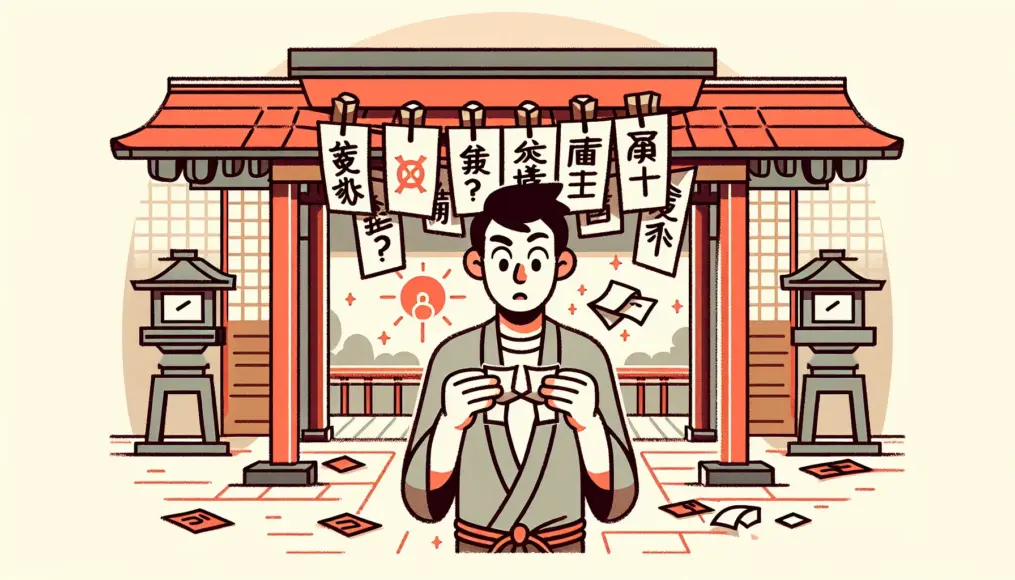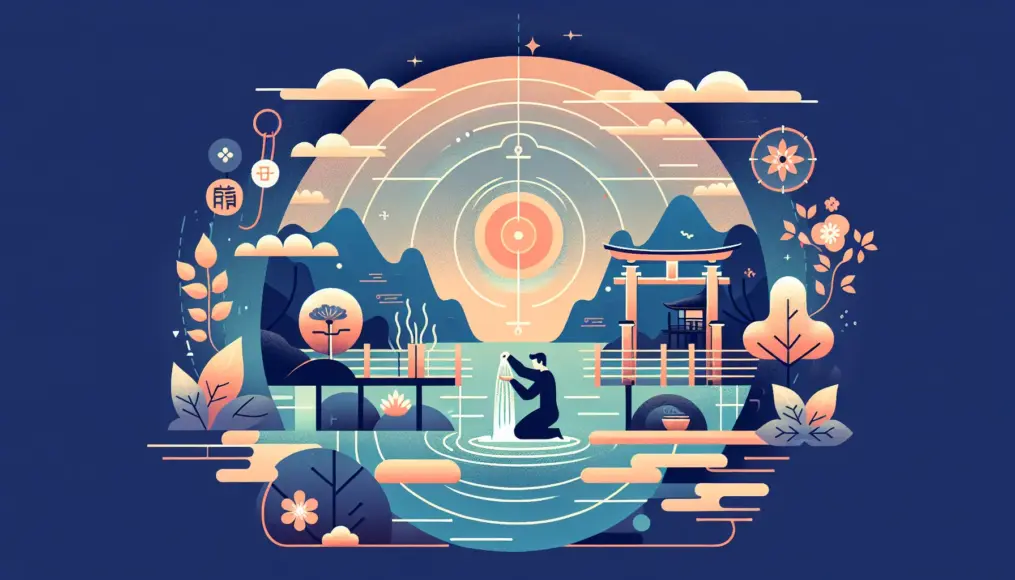When you draw a bad fortune (kyo) from an omikuji, it’s natural to feel taken aback. However, it’s important to realize that this “bad luck” often carries a deeper spiritual significance. Kyo isn’t just a sign of misfortune; it frequently points to pivotal moments in life and opportunities for personal growth. In this article, we’ll delve into the spiritual messages behind kyo and explore how to interpret them positively.
It’s also crucial to understand how to reframe a bad fortune in a constructive way. By shifting your perspective on negative events, you can turn them into catalysts for self-improvement. We’ll share tips that can help you embrace the challenges of daily life and use them as stepping stones toward a brighter future. Let’s believe in the power of omikuji and find actionable steps to move forward.
We’ll also discuss the fresh perspectives that can emerge from experiencing kyo and how these insights can affect our lives. Why not take this opportunity to rediscover the allure of omikuji for yourself?
- The Spiritual Messages Behind Kyo
- How to Turn Negatives into Positives
- The Power of Omikuji and Its Impact
The Spiritual Message Behind a Bad Fortune
When you draw a bad fortune (kyo) from an omikuji, it’s easy to feel disheartened. However, if we look at it from a spiritual perspective, there’s a deeper meaning embedded in that bad fortune. It’s not just a sign of misfortune; rather, it suggests trials and changes in life. In this section, we’ll explore the spiritual message of a bad fortune and how to interpret its meaning.
When you receive a bad fortune, it’s crucial to keep an open heart and be ready to absorb its message. From a spiritual standpoint, understanding what a bad fortune signifies can lead to personal growth and new insights. In the following section, we will delve into what a bad fortune means and how to cultivate the mindset needed to embrace its message.
What a Bad Fortune Signifies
A bad fortune is not merely a symbol of bad luck; it can also be seen as a sign of change and growth. For instance, when you draw a bad fortune, it’s a chance to reflect on your current situation. If you’re not satisfied with where you are, that bad fortune is nudging you to reconsider. In fact, drawing a bad fortune often serves as a catalyst for self-reflection, guiding you toward a better path.
Moreover, a bad fortune carries a message that encourages personal development. Facing difficulties can help us acquire new skills and become stronger. Understanding the meaning behind a bad fortune and reflecting on what we can learn from it is vital.
- A bad fortune signifies change and growth
- It offers an opportunity to reevaluate your current situation
- It’s a chance to gain new skills and strength
Cultivating the Right Mindset to Receive the Message
When you draw a bad fortune, maintaining a positive mindset is essential. To truly receive the message of a bad fortune, it’s important to acknowledge your emotions honestly. Even if you feel down, accepting those feelings instead of denying them will help you move forward.
Additionally, to grasp the message a bad fortune conveys, it’s crucial to open your mind and reflect on its significance. Drawing a bad fortune might just lead you to gain fresh perspectives or insights. Let’s view it as an opportunity for personal growth and approach it with positivity.
- It’s important to maintain a positive mindset
- Accept your emotions honestly
- See it as an opportunity to gain new perspectives and insights
A Positive Perspective on Drawing a Bad Fortune
When many people pull a bad fortune, or “kyou” omikuji, they often find themselves feeling down. However, there are actually positive ways to interpret this seemingly negative outcome. A bad fortune can serve as an important message, offering opportunities for personal growth and new insights. In this section, we’ll explore how to turn a bad fortune into a stepping stone for self-improvement and share tips on transforming negative feelings into positive ones.
Drawing a bad fortune can be a chance for us to grow. By accepting the negative situation and reflecting on what lessons can be learned from it, we can enhance our quality of life. Let’s take this opportunity to discover how we can do just that.
How to Utilize a Bad Fortune for Self-Growth
When you draw a bad fortune, it’s essential to reflect on its meaning to facilitate personal growth. Start by closely examining the issues or challenges that the bad fortune highlights. By objectively analyzing the obstacles and anxieties you face, you can identify the path forward.
It’s also crucial to take this moment to reassess your values and goals. By dedicating time to think about what truly matters and how you want to live your life, you can gain a clearer direction for your self-improvement journey.
- Reflect on the meaning of the bad fortune and identify problems
- Reassess your values and goals
- Clarify your direction for moving forward
Tips for Turning Negativity into Positivity
To shift the negative feelings that arise from drawing a bad fortune into something positive, the first step is to acknowledge your emotions. Instead of suppressing your disappointment, allow yourself to feel it genuinely; this prepares you to move on to the next step.
Additionally, finding small things to be grateful for in your daily life can be incredibly effective. By focusing on the small joys around you, you can ease negative feelings and cultivate a more positive mindset. Use the experience of drawing a bad fortune as an opportunity to discover what brings you happiness.
- Accept negative emotions
- Focus on the small joys in daily life
- Cultivate a positive mindset
The Impact of Omikuji from a Spiritual Perspective
Omikuji, the traditional Japanese fortune-telling paper strips, are considered a vital way to receive spiritual messages. Particularly when one draws a “kyo” (bad fortune), the message carries a special significance. The wisdom and inspiration we gain from omikuji often influence our daily lives and life choices. In this section, we’ll explore the power of omikuji and how its results can shape our lives.
Far from being just a game of chance, omikuji serve as a tool for self-understanding and personal growth. When faced with a bad fortune, embracing its message can lead to positive changes. Let’s delve into the specific powers that omikuji hold.
The Power of Omikuji
Omikuji have a unique ability to tap into our subconscious. Especially when we draw a bad fortune, they provide an opportunity to reassess our current situation and reflect inwardly. A bad fortune is a crucial message prompting us to reconsider our future actions and thought processes.
Additionally, the spiritual energy we sense through omikuji helps heal our hearts and encourages our growth. It is precisely because of a bad fortune that we are able to gain new perspectives and make strides in our self-development.
- Omikuji have the power to influence our subconscious
- Bad fortunes prompt us to reassess our current situation
- Spiritual energy helps heal our hearts
Impact on Our Lives
The outcomes of omikuji can have various influences on our lives. When we draw a bad fortune, we can discover new paths or find the strength to overcome challenges through its messages. Thus, omikuji are not merely about predicting luck; they serve as essential guides in our lives.
Moreover, by accepting the results of omikuji and learning from them, we can enrich our lives. Instead of feeling disheartened by a bad fortune, we can use that experience as a stepping stone for growth.
If you’re intrigued by the spiritual messages that come from drawing omikuji, you might also enjoy this article, “What is the Spiritual Meaning Behind Uncontrollable Tears?.” Behind our tears often lies a profound message from within, offering insights that can lead to personal growth. Be sure to read it alongside this one to deepen your spiritual awareness.
- Omikuji serve as guides in our lives
- Bad fortunes help us find new paths
- We can grow through experiences and enrich our lives
What to Do After Drawing a Bad Omen
So, you’ve drawn a bad omen—what’s next? The first step is to truly absorb the message behind it and incorporate it into your daily life. A bad omen isn’t just a sign of misfortune; it can also serve as an important signal for growth and change. In this section, we’ll explore actionable steps to take after experiencing a bad omen and how to gain a fresh perspective.
It’s vital to approach a bad omen with a positive mindset. Use this opportunity to reassess your life and thought patterns. Let’s consider specific actions you can take to turn the negative effects of the omen into something beneficial.
Practical Steps in Daily Life
When faced with a bad omen, there are several practical steps you can take in your everyday life. Start by examining your actions and thoughts. For instance, beginning a new hobby or diving into self-help books can help you gain a deeper understanding of yourself.
Moreover, embracing gratitude is essential for accepting the message of the omen. By recognizing the small joys and blessings in life, you can generate positive energy that leads to emotional healing.
- Reassess your actions and thoughts
- Start a new hobby
- Appreciate the small joys in daily life
Steps to Gain a New Perspective
To gain a fresh perspective, it’s important to open your heart and look inward. After drawing a bad omen, take the time to observe your emotions and circumstances, considering what lessons you can learn from them. This reflection can unlock new avenues for personal growth.
Additionally, discussing your thoughts with friends and family can be incredibly helpful. Engaging with others can reveal insights you might have missed on your own, enriching your understanding of the situation. Use the experience of drawing a bad omen as a catalyst for meaningful communication with those around you, and take steps towards your personal development.
- Observe your emotions and circumstances
- Talk things over with friends or family
- Integrate others’ perspectives
Conclusion
When you draw a bad fortune (kyo) from an omikuji, how you respond to that outcome is crucial. A bad fortune is not just a sign of misfortune; it carries important messages for personal growth and new realizations. From a spiritual perspective, viewing a bad fortune positively can help you discover opportunities for change and growth in your life.
In everyday life, it’s essential to embrace the messages that a bad fortune conveys and deepen your self-understanding. By accepting negative emotions while maintaining a sense of gratitude, you can build a richer and more fulfilling life. Utilizing the spiritual insights gained from omikuji, it’s important to move forward with a positive outlook.
- A bad fortune is a message for personal growth
- By viewing it positively, you can gain new perspectives
- Practicing these insights in daily life can have a positive impact
How you choose to apply the results of your omikuji can significantly influence your life. We’d love to hear your experiences, so feel free to share your thoughts in the comments!



Comment